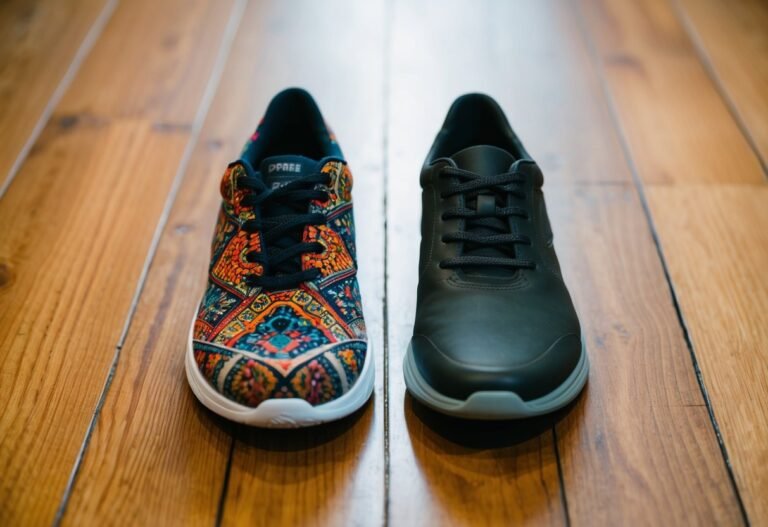Pros and Cons of Wearing Slippers in the Gym: A Hygiene and Safety Debate
Key Takeaways
- Proper gym footwear is crucial for safety, hygiene, and performance during workouts.
- Slippers may not offer the necessary support, protection, or traction needed for gym activities.
- Prioritize athletic shoes like running shoes, crosstraining shoes, or hiking shoes that are designed for physical activities.
- Wearing slippers in the gym can lead to discomfort, injuries, slipping hazards, and hygiene concerns.
- Exceptions for wearing slippers include light activities like stretching or yoga in a controlled environment.
- Consult with professionals if medical conditions require specific footwear but prioritize safety and support in any case.

Overview of Wearing Slippers in the Gym
In considering the appropriateness of wearing slippers in the gym, it’s essential to focus on aspects beyond just comfort. Gym hygiene and safety are significant factors that we need to take into account when choosing our workout attire.
Wearing slippers in the gym can pose hygiene concerns as gym floors are exposed to various bacteria and germs. Slippers may not provide adequate protection or support during workouts, increasing the risk of foot injuries. Additionally, in the current context of heightened awareness around cleanliness due to COVID-19, wearing slippers in the gym may not align with the emphasis on maintaining a sanitized environment.
While slippers may be comfortable for casual wear, they are not designed to withstand the intensity of gym workouts. Running shoes, cross-training shoes, or hiking shoes are more suitable choices as they offer the necessary support, stability, and cushioning required for different types of physical activities. These shoes are specifically designed to enhance performance and protect our feet during exercise routines.
Opting for proper athletic shoes over slippers can help prevent slips, falls, and other potential injuries that may arise from inadequate foot support. It’s important to prioritize our safety and well-being in the gym environment by wearing appropriate footwear that is specifically designed for physical activities.
Considering the impact of our attire on hygiene, safety, and overall gym experience, we should choose footwear that aligns with the demands of our workouts and contributes to a positive and safe gym environment for everyone.
Pros of Wearing Slippers in the Gym
When considering the appropriateness of wearing slippers in the gym, it’s essential to acknowledge some potential benefits, although they come with caution. While slippers are generally not recommended for gym use due to safety and hygiene concerns, there are a few instances where they might have some advantages:
- Quick and Easy Wear: Slippers are convenient to slip on and off, making them a hassle-free option for individuals who want to quickly transition between different areas of the gym.
- Comfort During Light Activities: For light activities like stretching, yoga, or post-workout relaxation, wearing slippers may provide a sense of comfort and relaxation for some individuals.
- Foot Protection from Cold Floors: In colder climates or if the gym floor tends to be chilly, wearing slippers can help keep your feet warm and protected from the cold surface.
- Non-Slip Soles: Some slippers have non-slip soles that can offer traction on smooth surfaces, potentially reducing the risk of slipping or sliding during exercises.
- Personal Comfort Preference: Ultimately, personal comfort plays a significant role in one’s workout routine. If wearing slippers enhances your comfort level and doesn’t compromise safety, it might be an acceptable choice for certain low-impact activities.
While these benefits highlight some positives of wearing slippers in the gym, it’s crucial to weigh them against the potential risks and limitations. Prioritizing safety, hygiene, and proper footwear designed for physical activity remains paramount to ensure a safe and effective workout experience for all gym-goers.

Cons of Wearing Slippers in the Gym
Slippers may seem comfortable for a casual day at home, but when it comes to the gym environment, wearing them poses several drawbacks. Here are some cons to consider before choosing slippers as your workout footwear:
- Lack of Foot Support:
Slippers typically lack the necessary arch support and cushioning required during physical activities like exercising at the gym. This lack of support can lead to discomfort, foot pain, and even injuries during high-impact movements. - Increased Risk of Slipping:
The smooth and often slippery soles of slippers are not designed for the traction needed on gym floors. Using slippers increases the risk of slipping, especially when performing exercises that involve quick movements or lifting weights. - Limited Protection:
Slippers offer minimal protection for the feet compared to proper gym shoes. In a gym setting where heavy equipment and weights are used, inadequate foot protection can result in injuries if something falls or is dropped accidentally. - Hygiene Concerns:
Gyms are shared spaces with various individuals using the same equipment and facilities. Wearing slippers exposes your feet to potential infections, fungus, and bacteria present on gym floors due to the lack of barrier protection. - Non-Compliance with Gym Rules:
Many gyms have specific rules regarding appropriate footwear for safety reasons. Wearing slippers disregards these rules and may lead to gym staff requesting you to change into proper shoes, causing disruptions to your workout routine.
Considering these disadvantages, it’s essential to prioritize safety, support, and hygiene by opting for appropriate athletic footwear designed for physical activity when working out in the gym.
When It Might Be Acceptable to Wear Slippers in the Gym
In some rare cases, wearing slippers to the gym might be deemed acceptable. If you’re engaging in light stretching or doing yoga in a designated area away from heavy gym equipment and free weights, slippers could be considered adequate. These activities involve minimal movement and can benefit from the flexibility and comfort that slippers offer.
Moreover, if you have a medical condition that requires you to wear a specific type of footwear for support or comfort, such as certain foot conditions, neuropathy, or post-injury recovery, wearing slippers with arch support or cushioning might be permissible during your workout. It’s crucial to consult with a healthcare professional or a physical therapist before opting for slippers in such cases to ensure you’re not compromising your safety or health.
Additionally, in a home gym setup where you have full control over the environment and cleanliness, wearing slippers might be more acceptable. This controlled setting minimizes the risk of slipping on unfamiliar surfaces and reduces exposure to potential hygiene issues commonly associated with shared gym spaces.
However, even in these exceptional circumstances, it’s important to consider the potential risks and limitations of wearing slippers during a workout. While there are a few scenarios where slippers could be acceptable, they should not be a common choice for gym footwear due to the safety, support, and hygiene concerns associated with them. Prioritizing proper athletic shoes designed for physical activity remains the best practice for most gym-goers to ensure a safe and effective workout session.
Alternatives to Wearing Slippers in the Gym
When considering suitable gym attire, it’s essential to prioritize safety and performance. While slippers may offer comfort at home, they’re not the best choice for rigorous workouts in a gym setting. Here are some practical alternatives to wearing slippers during your gym sessions:
- Athletic Shoes: Opt for proper athletic footwear designed for the specific physical activity you’ll be engaging in. Brands like Brooks, Asics, Nike, Reebok, New Balance, and more offer a variety of shoes tailored to different workout routines, such as running, crosstraining, and hiking.
- Running Shoes: If your workout routine involves running on a treadmill or outdoors, invest in quality running shoes that provide cushioning, stability, and motion control. Brands like Brooks, Asics, and Nike offer popular models like the Brooks Ghost, Asics Gel Nimbus, Brooks Adrenaline, and Nike Zoom Structure.
- Crosstraining Shoes: For activities that require lateral movements and support for weightlifting or high-intensity interval training, crosstraining shoes like the Reebok Nano, Nike Metcon, or New Balance Fresh Foam Roav are excellent choices.
- Hiking Shoes: When hiking or engaging in activities that require good traction and ankle support, consider hiking shoes from reputable brands like Merrell, Columbia, or Salomon.
- Sneakers or Trainers: If you prefer a more casual and versatile option, sneakers or trainers from well-known brands like Adidas, Puma, or Under Armour can provide the comfort and support needed for your gym workouts.
By opting for appropriate athletic footwear over slippers, you can ensure better stability, support, and protection for your feet during various workout routines. Remember, wearing the right shoes can enhance your performance and reduce the risk of injuries while exercising in the gym.
When it comes to wearing slippers in the gym, prioritizing hygiene, safety, and proper footwear is key. While there may be exceptions for light activities or medical needs, it’s crucial to weigh the risks. Opting for specialized athletic shoes from trusted brands like Brooks, Asics, Nike, Reebok, or New Balance ensures the necessary support and protection during workouts. Remember, the right shoes can enhance your performance and prevent injuries, making them a worthwhile investment for your fitness journey. Choose wisely, stay safe, and enjoy your gym sessions to the fullest!
Frequently Asked Questions
Why should you avoid wearing slippers in the gym?
Wearing slippers in the gym can lead to inadequate protection and support on gym floors, compromising your safety and hygiene during workouts.
When is it acceptable to wear slippers in the gym?
In certain scenarios like light stretching or yoga in designated areas, for individuals with medical conditions requiring specific footwear, or in home gym setups where slipper use may be permissible with caution.
What are alternatives to wearing slippers in the gym?
Opt for athletic shoes tailored to specific activities like running, crosstraining, and hiking. Brands like Brooks, Asics, Nike, Reebok, and New Balance offer a variety of shoes designed for different workout routines.











